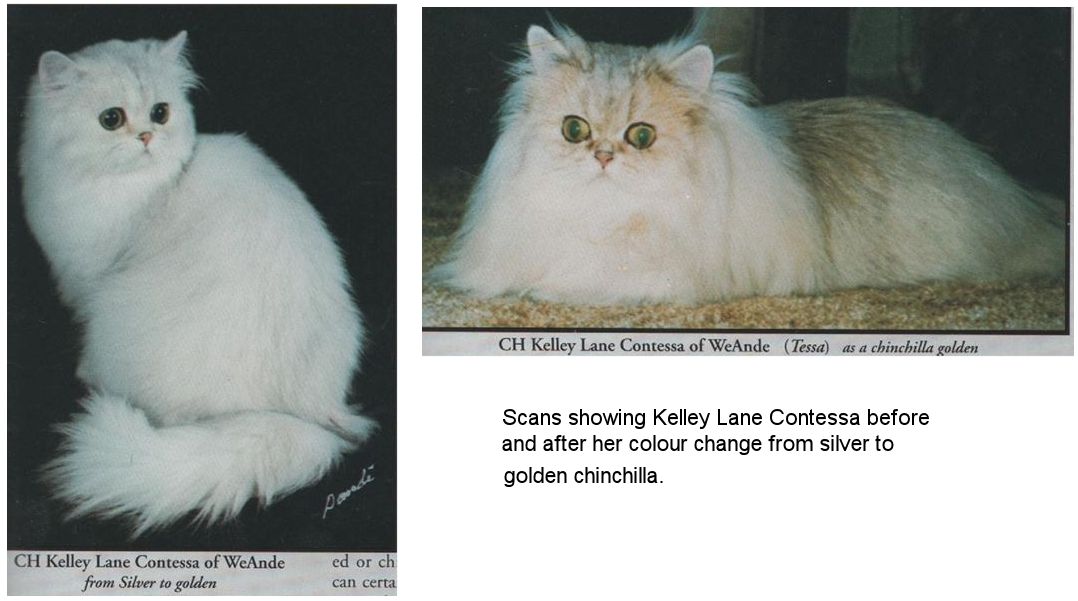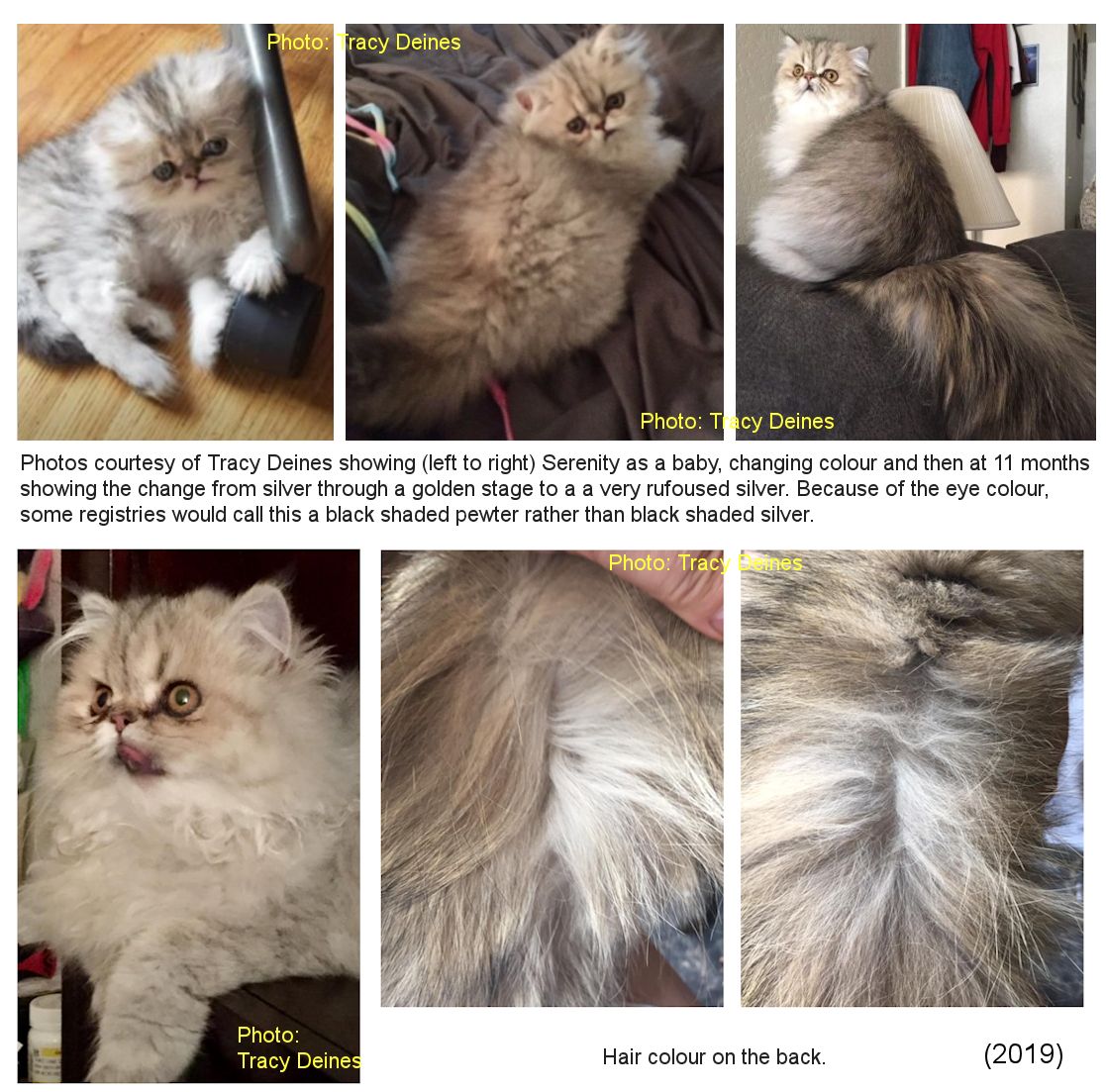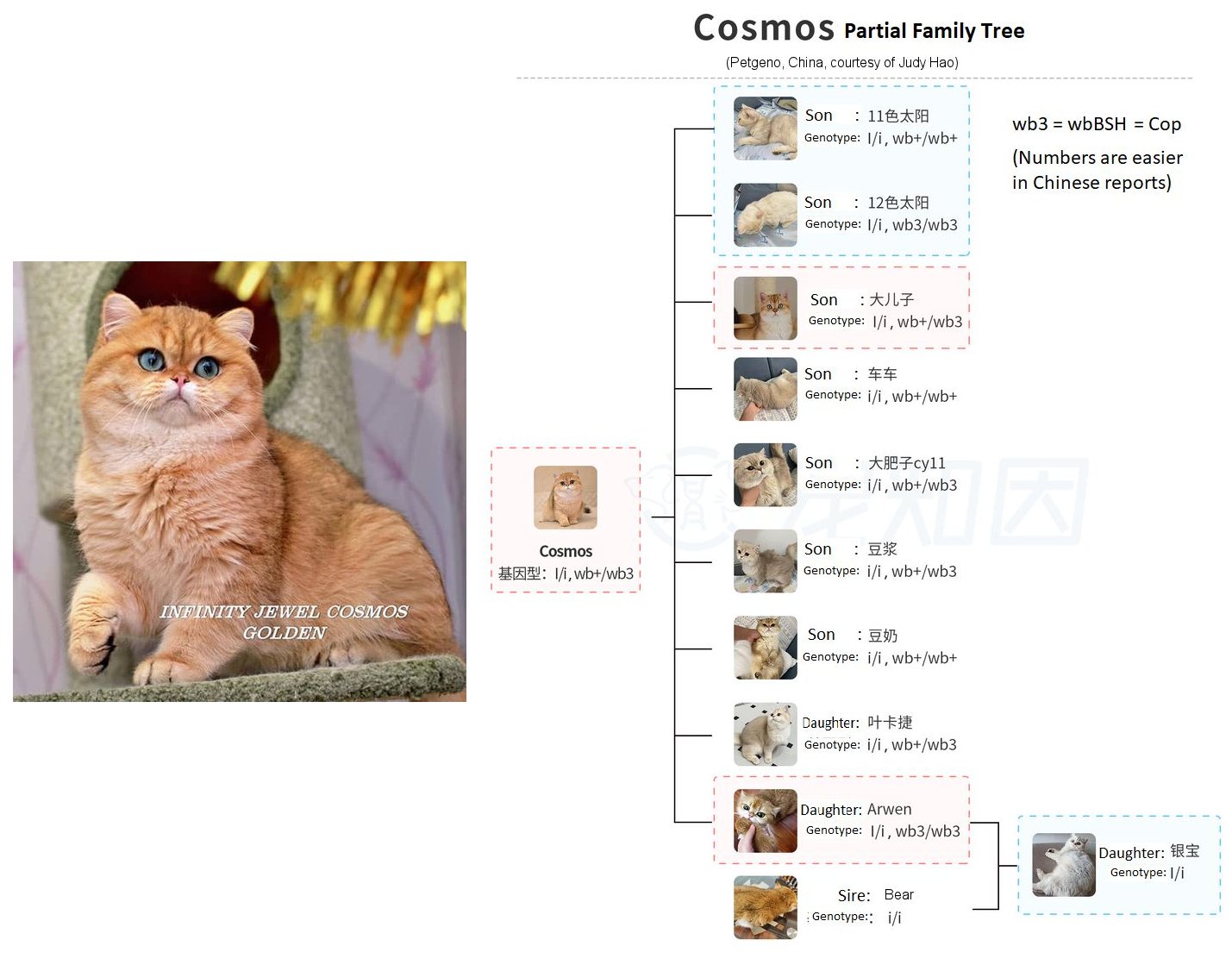
"PLATINUM" PERSIANS (SILVER-TO-GOLD LATE COLOUR CHANGE)
While silver-and-gold has turned up in Siberians (Bimetallic Siberians), a silver-TO-gold effect has turned up in some lines of Silver Persian/Chinchilla Longhair where it has been dubbed "platinum". The description of the colour change sounds similar to the Amber and Russet genes Amber and Russet - Late Colour Change Genes
A bit of background to silver and golden colours: Golden had been seen in silver lines in Britain since the 1920s, but were not recognised and not registered. They were recognised in the USA in 1970. This means line-chasers cannot find out from databases whether silver cats in pedigrees had any golden siblings, hitting a dead end in when the trace back to 1970. In the USA, most silver lines trace back to Allington lines and Gray Ivy lines. But what we are interested in here are not the normal goldens that occur alongside silvers, but cats that start out as silver and turn golden later in life.
In 1986/7, Cheryl Bennett reported in The Silver and Golden Persian Newsletter (ACFA) that one of her shaded silver females (Kelley Lane Contessa of WeANDE) had changed from pure silver to pale golden. Contessa s parents were a shaded golden and a shaded silver; these were full siblings. At 10 12 months of age, Contessa began to tarnish i.e. show cream/reddish patches and by 3 years of age she was entirely pale golden. She produced a number of Silver Persians without tarnish, but she failed to produce any offspring when mated to a golden sire. One of Contessa s male offspring turned from silver to golden as an adult.
An adult Silver Persian from England (Lynchard Silver Shadow) was exported to Australia as an almost snow white kitten, but later turned golden. Silver Shadow had a few golden hairs on his paw, and his whole coat turned a pale beige when he was a year old. By 3 years old he was entirely pale golden. Silver Shadow was bred to a genetically golden female, but the pairing only produced silver offspring. However, at least one of his silver offspring later turned pale golden, again suggesting a late colour change gene rather than genetic golden. Other descendants of Contessa also went through the late colour change. During the 1980s, several other breeders of Shaded Silver and Chinchilla Persians came forward to report that their cats had developed reddish, brownish or golden-coloured fur along their spines as they aged. Many of the cats had no golden in their ancestry. At first it was dismissed as an unavoidable genetic fault where silver was incompletely dominant and did not hide the recessive golden colour. A change of colour from black-based to reddish, starting at the spine and spreading outwards, is typical of the Amber gene.
Ana-Lan's BB, her great-grandmother and her grandsire, all turned golden by age two. Ana Lan's maternal grandsire is Platinum Beginning who traced back to Contessa. However, the idea of a new late colour change mutation was obfuscated by the fact that she also had genetic golden ancestors.

Another cat linked to the colour-changing Silver Persians was a stud cat called Kelly Lane Andromeda who shared a common ancestor with Contessa - Wicklow Donnybrook(in the UK) whose descendents were exported to the USA in the 1950s and 1960s. Some of those descendants were influential stud cats and would have spread the mutant gene far and wide.
It takes 2 carriers to produce a colour-change cat. Mary Crary Boy Tage of WeANDE appears to have been a carrier, but is not related to Wicklow's Donnybrook. He shares an ancestor with Kelley Lane Andromeda 4-5 generations back via Mary Crary Frivolous, but because all colour change cats trace back multiple times to Wicklow Donnybrook, I still think he may be the origin, although the lack of connection to Mary Crary Boy Tage is interesting (is it possible Platinum Beginning s sire was actually a different male?).
Like many American silver and golden lines, Kelly Lane Andromeda is connected to two early Allington imports from the UK. Firstly there is the chinchilla silver Hazeldene Felis (Fidelio of Allington x Mandy of Allington) who went to the Delphi cattery in the USA. Secondly there was Beverly-Serrano Honey, a silver born pre-1953 to Fanfare of Allington (UK) x Lindy Lou of Beverly-Serrano. Wimauma Faustino of Allington was another English stud who contributed his genes in 1954. But all of that is a long time back and the colour change had not been reported in other lines descended from those cats. Therefore, Wicklow Donnybrook, a more immediate ancestor, is a more likely origin.
Controlled inbreeding (linebreeding) helped establish the gene, which would later double up to produce colour-changing Silver Persians. The effect of this gene on Golden Persians, if indeed it has any effect, is not known. Except for red-silvers and cream-silvers, silver cats should entirely lack phaeomelanin (red or cream pigment) and only have eumelanin (black, brown, blue etc) present. Perhaps some other gene causes the eumelanin structure to change so that it is perceived as a golden colour. Chemical analysis at the time proved that the late colour change Silver Persians did not have phaeomelanin pigment present.
From the descriptions of the colour change, the age and way it occurred and the fact that the cats did not breed as genetically golden Persians, I believe that these late colour change Persians were due to a mutation that decreases the inhibitor gene s ability to suppress pigment. Genetically the colour changing cats are silver (and breed as silver) but the additional mutation turns them golden in later life. In 2023 genes were found that regulated the inhibitor gene, although the inhibitor gene itself was not found.

LATE COLOUR CHANGE UPDATE JULY 2023, PETGENO, CHINA (JUDY HAO) - BRITISH SHORTHAIR/BRITISH LONGHAIR
The British Shorthair and British Longhair have inherited many colour genes from Persian Longhairs to improve the conformation or introduce new colours. See Corin Gene: Sunshine British Shorthairs/Longhairs
In China, Arwen, a golden female, and Bear, also golden, produced a silver kitten, Yin Bao. Arwen s breeder reported that Arwen had previously produced 4 silver kittens in her litters. None of the silver offspring have been bred, so there is no data on what they transmit. The golden offspring mated with different tipped/shaded golden female cats were able to produce silver offspring.
Arwen's father, Cosmos, is a golden bred at Infinity Jewel cattery (Russia, St. Petersburg) by Viktoria Podkopaylo. His full name is Infinity Jewel Cosmos Golden. Mr. Liang Shang purchased Cosmos as his main stud cat. Mr. Liang has studied gold, gold and silver for many years and summarized a lot of very valuable information. Cosmos s breeders of Cosmos were confused and upset that Cosmos produced both gold and silver offspring as it meant the authenticity of his pedigree was questioned.
To verify Cosmos s ability to produce silver, Mr Liang he mated him with several shaded golden females from different blood lines. No matter which female cat Cosmos mated with, there were some silver offspring, but these were not simple tipped/shaded silvers. The silver was very obvious in the kittens, but as they grew they developed more golden colours. The outer coat and guard hairs were more silvery, while the soft undercoat was more golden. Because cats shed most of their undercoat when moulting, the gold and silver levels of sunshine individuals varied greatly at different stages of their moult, but in general, as they grew older they became more golden. The breeders called this sunshine, a name borrowed from Siberian cats.

Some of Cosmos s golden descendants, such as Arwen, also produced silver offspring. Although these descendants were golden from birth to adulthood, they produced "sunshine" offspring. Because silver is a dominant gene, something else must be happening. Two non-silver parents should not produce silver offspring.
Could this be a new recessive silver gene that can be carried by non-silver parents? Or could it be a gene at a different locus that prevents the well-known dominant inhibitor gene (silver) from working? Petgeno in China collected samples from all relevant individuals and analysed their silver gene genotypes. All the tipped/shaded golden individuals that were able to produce both gold and silver offspring (e.g. Cosmos, Arwen and the eldest son) had the silver gene. All "sunshine" individuals in the pedigree also had the silver gene. The golden chinchilla/shaded golden individuals that did not produce "sunshine" offspring did not have the silver gene.
The sunshine colour was caused by the silver mutation, but some other gene interfered with how silver was expressed. That other gene had to be semi-dominant. When heterozygous (one copy) it partially suppressed silver and gave the sunshine colour ( silver sunshine ). When homozygous (2 copies) it completely suppressed the silver gene, producing the tipped/shaded golden colour ( pink sunshine ). When this other gene was present (1 or 2 copies) but there was no silver gene, the other gene could not be expressed (in the same way that non-agouti silver cats are smokes because there is no yellow band for the silver to act upon).
Breeders wondering whether they have a tipped/shaded silver/golden cat or a sunshine cat can now test for silver. "Sunshine" cannot be simply classed as tipped/shaded silver based on appearance, because those silver-carrying sunshine individuals start off silver but turn gradually golden as they mature. A cat with the new gene that suppresses expression of silver cannot simply be called tipped/shaded silver because its adult colour will look golden so a new name is needed to differentiate them.
Because there are tests for silver, breeders interested in the new "sunshine" colour can test golden-looking cats to see if they also have the silver gene; these cats can produce sunshine offspring. To avoid the sunshine colour they should avoid using cats that have the silver gene.